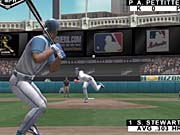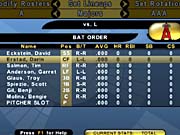3DO's long-running baseball series is back with High Heat Major League Baseball 2004, a game that makes improvements to the series, but has just enough problems to compromise what it does right. Even the redesigned graphics, extra options on the field, and the new franchise mode frills aren't as exciting as they should be, thanks to an obtuse interface that doesn't offer mouse support and also has a number of apparently broken features. While you can pick up High Heat 2004 and still have a great ball game, the PC version's console-game-style menu system and other issues make it difficult to appreciate anything else, which is a real problem in a game where half of the fun is juggling your roster, tweaking your pitching rotation, and negotiating with troublesome free agents.

High Heat 2004 didn't have to turn out this way. With the exception of the game's interface issues and the incomprehensible decision to leave out mouse support, 3DO has done some impressive work modernizing the look and feel of the series with its latest game. In fact, High Heat 2004 is easily the best-looking game in the history of the series. The graphics engine has been rebuilt from the cleats up. The game's motion-captured player models are loaded with more polygons than ever before, replacing the awkward, stiff player animation you may have seen in previous games in the series. The game also has updated graphics for the stadiums. Better shadow effects make parks like historic Yankee Stadium and even the antiseptic SkyDome loom above players' heads like the monolithic structures they are. Refined dirt and grass textures complete the look.
But even while attention to finer details helps give the game an authentic ballpark atmosphere, High Heat 2004's graphics aren't exactly perfect. Player faces still resemble mannequins more than human beings, although they are closer to their real-world counterparts than ever before. The game also has poor collision detection, so you'll routinely see infielders going back for pop-ups and then running right through outfielders coming in on the play, as well as some graphical clipping and tearing, especially with player uniforms. And the interface bars in the game screens don't scale with the resolution, so you'll be playing the "large print" version of the game even at resolutions of 1280x1024 and above, complete with blurred player photos.
High Heat 2004's audio is another matter. Specifically, the game's sound has been left largely unchanged, particularly the play-by-play commentary from Dave O'Brien and color commentator Chuck Valenches, who repeat the same lines they had in High Heat 2003 (many of which were used previously in High Heat 2002). Fortunately, the in-game sound effects have been greatly improved since last year, but that's largely because the developer has worked on clearing up the sound bug that sometimes caused the game's audio to be covered in static. The crack of the bat, the umpire calls, and even the hecklers in the crowd sound exactly the same as they have for the past two or three years, and the effects certainly aren't getting any newer.
Of course, better graphics and sound are hard to appreciate if a game doesn't have a usable interface. High Heat 2004 for the PC uses exactly the same interface as High Heat 2004 for the PlayStation 2, which will pose certain problems if you happen to use a mouse for your computer (like everyone who owns a computer does). The game's lack of mouse support will definitely disappoint High Heat PC veterans, who have become accustomed to the PC series' drag-and-drop interface, which made it easy to shuffle your lineups, demote players to the minors, or just get someone throwing in the bullpen. In High Heat 2004, you have to use a gamepad to navigate menus while you're not playing a ball game and switch to your keyboard while you are playing a game. This clunky system puts important options in strange places within the interface, and it also makes some important stats inaccessible at times. On-base percentage, for example, can't be found on the batting order screen, and player rosters can't be accessed without pausing a game in progress. Things are so convoluted that it's hard to use High Heat 2004's new career-oriented options like player contracts, salaries, and team budgets. It's almost as if the game were purposely designed to confuse anyone who played it.
However, there are times when the interface doesn't matter. High Heat 2004 continues the series' long tradition of realistically depicting baseball on the diamond, and it even adds some features that give the game more of a big-league character. Important in-game attributes can now be altered with slider bars. Veterans of the PC series have always been able to adjust such things by manually editing the game's "tune" file (still available for tweaking the finer points), although it's nice that you can now change such things as pitch speeds and computer hitting skill without leaving the game. The pitcher-batter duel is as solid as ever, and it has been bolstered with more pitch types. This makes pitchers closely resemble the real big leaguers. Pedro Martinez, for instance, now has access to his fading fastball and circle change, and Orlando "El Duque" Hernandez can throw his slow hook and "El Droppo." A new mode of play, two-on-two showdown, emphasizes how much fun it is to go head to head by getting rid of all the fielders. The game's statistics generation is also pretty much dead-on.

However, High Heat 2004 also has problems on the field. While the new game features all the solo modes of play from the previous games in the series, High Heat 2004 no longer supports online or network-based multiplayer play. The only way to take on a friend is by sitting side by side at the same computer. There is a two- or three-second delay before you're allowed to choose pitches during games, which is annoying and makes the overall game much more time-consuming. Also, in the single-player game, your computer opponents have poor artificial intelligence in both the franchise and career modes. Computer teams don't seem to trade among themselves, they're all over the place in the deals that they'll consider from human opponents, and they can be so stingy with cash that they won't make offers to all-star free agents. And last but not least, High Heat 2004's roster of stadiums has been trimmed down to include only the current roster of Major League parks, so you can forget about revisiting the Polo Grounds or Ebbets Field this year.
All these issues make playing High Heat 2004 something of a chore. While you should be enjoying yourself, considering who should be hitting cleanup versus lefties, among other things, you'll instead find yourself constantly thinking about how much easier everything would be with a drag-and-drop interface. These and other issues constantly interfere with your appreciation of how the game plays on the field, unless you choose to skip the menu navigation and broken-feature headaches altogether and play nothing but exhibitions or the home run derby. Either way, it's doubtful that many baseball fans will be able to enjoy High Heat 2004 to its fullest.